Chicago and Milwaukee – Large Public Art and Placemaking
Daniel Burnham famously said “Make no little plans. They have no magic to stir men’s blood and probably will not themselves be realized.” Burnham, co-author of the famous 1909 Plan of Chicago, had a vision for a much grander Chicago. What he probably didn’t forsee was Chicagoan’s fulfilling that vision 100 years later by building massive pieces of public art. The latest iteration of Chicago’s fascination with large public art is located across the street from the iconic Harold Washington Library in Pritzker Park just northwest of the intersection State Street and Van Buren Street. What is it? A three-story tall eye ball, dubbed the EYE.
For a city that’s displayed to the world a giant bean, 25-foot tall American Gothic statue, and a massive Picasso statue, a three-story tall eyeball should really come as no surprise. Upon a viewer’s first impression the detail of the piece seem almost overwhelming. The EYE appears quite realistic with red veins on all sides. From across the street, or when attempting to push the piece over, the EYE appears incredibly lifelike. Thankfully it does not blink.
Unveiled July 7th, the EYE was designed by Tony Tasset and fabricated in Sparta, Wisconsin. As is par for the course with public art, someone must dismiss it by claiming it’s barely art. In this case it’s urbanist author James Howard Kunstler, who has named it his Eyesore of the Month for August 2010. The EYE will keep a watch on State Street shoppers until October. After that it’s fate is unknown, but given Illinois’s track record it might be wise to use it to keep track of the Governor’s office.
Large pieces of public art like the EYE are a breath of fresh air in large cities. They’re often capable of evoking a sense of place on their own. When the right location is selected, a piece of public art redefines the space it occupies. In this case Pritzker Park, a fairly sizable pocket park within the Loop, has been transformed into a destination.
Milwaukee has made some inroads on using public art. The controversial orange sculpture The Calling helps define the eastern edge of Wisconsin Avenue and serves as a gateway O’Donnell Park and Milwaukee Art Museum (which makes plenty of a statement on its own). Without the large sculpture, O’Donnell Park is nearly a surface parking lot, a massive piece of concrete. With the orange sunburst it’s at least a defined place, a mildly inviting pedestrian pass-through to the lakefront from downtown.
Coming in 2011 (and almost not at all), Janet Zweig‘s Pedestrian Drama flip-sign animation kiosks coming to Milwaukee’s Wisconsin Avenue will certainly make Wisconsin Avenue a bit more intriguing to walk down. The Milwaukee Riverwalk is adorned with jewelry and the Bronze Fonz (which despite criticism sees a steady stream of tourists).
Milwaukee would be wise to look to take advantage of large-scale public art with some of its urban parks. There are two well-located urban parks that would likely benefit the most, Cathedral Square and Pere Marquette.
Pere Marquette has the permanent gazebo, which functions well as a band shell and wedding photo opportunity spot. Beyond that though, the gazebo doesn’t draw many people into the park.
Cathedral Square has a great location, well-defined street wall surrounding it, and a layout that doesn’t make any sense at all based on park use. During the summer the park’s fountain is entirely covered by a stage for the well-attended Jazz in the Park. During the winter the fountain is turned off as the park is covered in snow and holiday lights. The holiday lights make the park a well-lit destination in the winter, but in the summer the park doesn’t encourage anyone to walk through it with the exception of one week. That one is Bastille Days, where MSOE’s miniature Eiffel Tower introduces a welcoming north anchor to the park and the roads are closed to traffic all around the park. Switching the stage location to the north end of the park would allow the fountain to return to summer operation, encourage more pedestrian activity, and open up the south end of the park for temporary art installations that invite more people into the area.
To take full advantage of public art, Milwaukee needs to start thinking bigger.
- Chicago’s newest piece of large-scale public art.


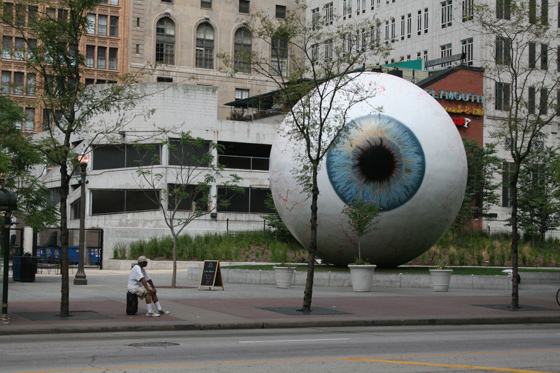
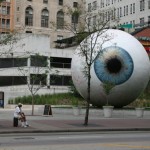
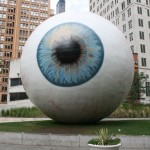
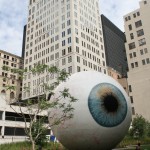
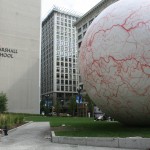
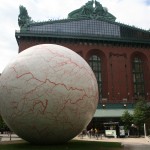
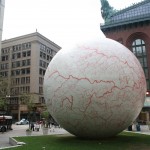
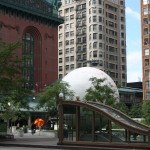
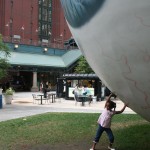




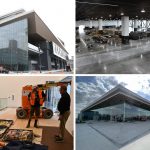










we should make a giant Ben Stein holding a Clear Eyes product! Sweeeeeet (Milwaukee is the relief to Chicago’s eyestrain)
As a long time Residents fan I sooo want to put a top hat on this thing.
this eyeball is great !
Please oh please, never let any of my tax dollars go to anything as creepy as this…